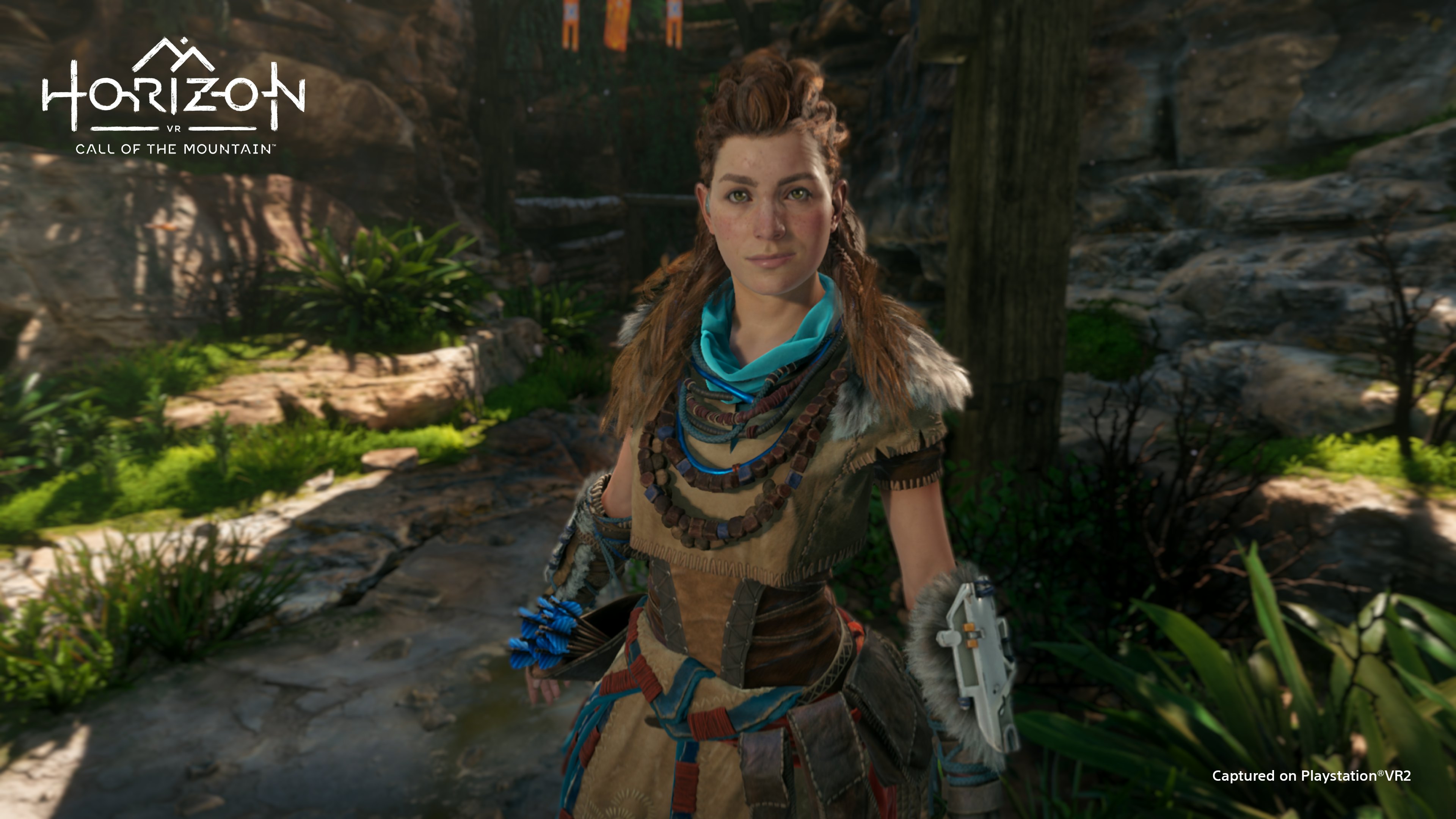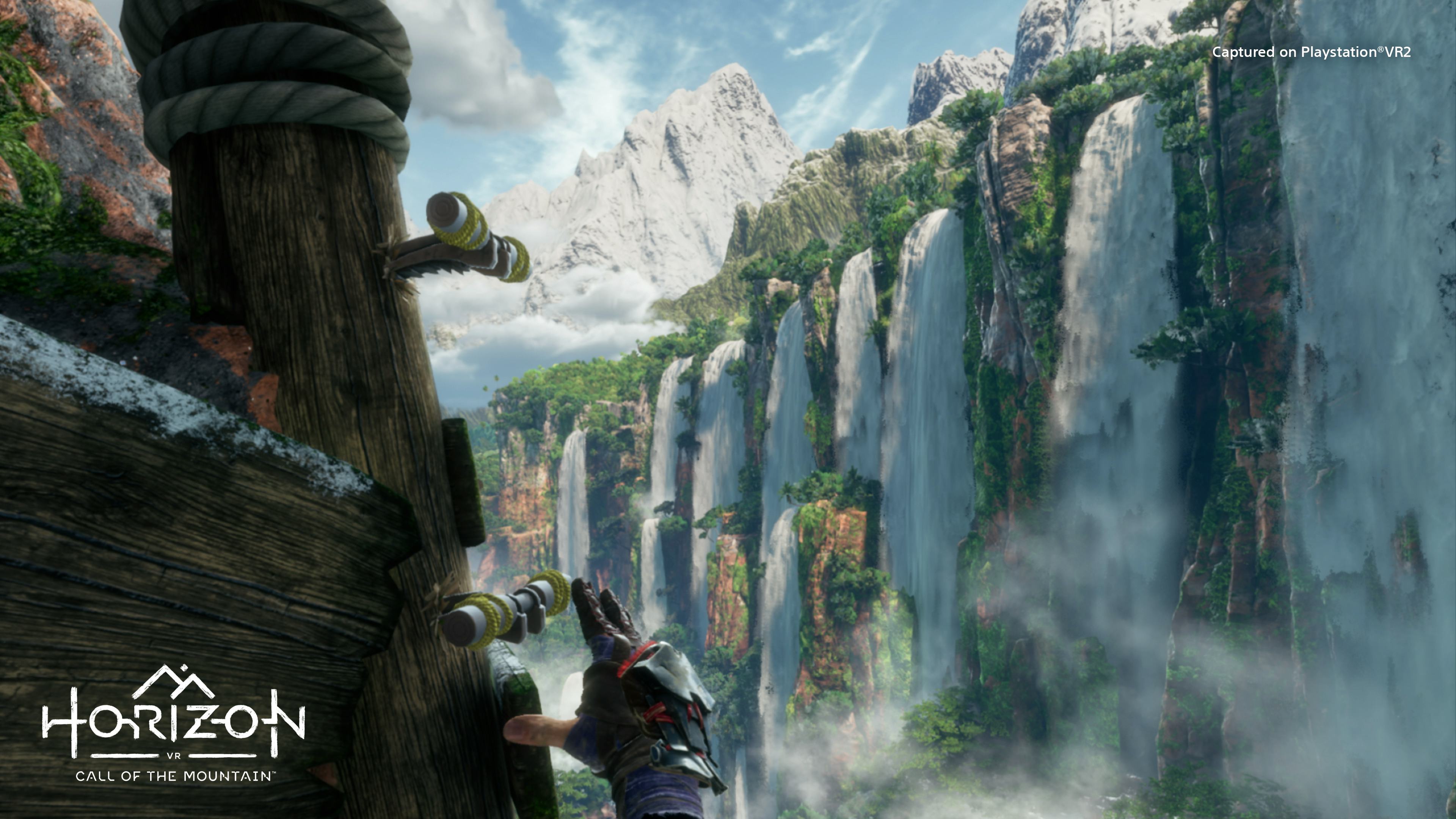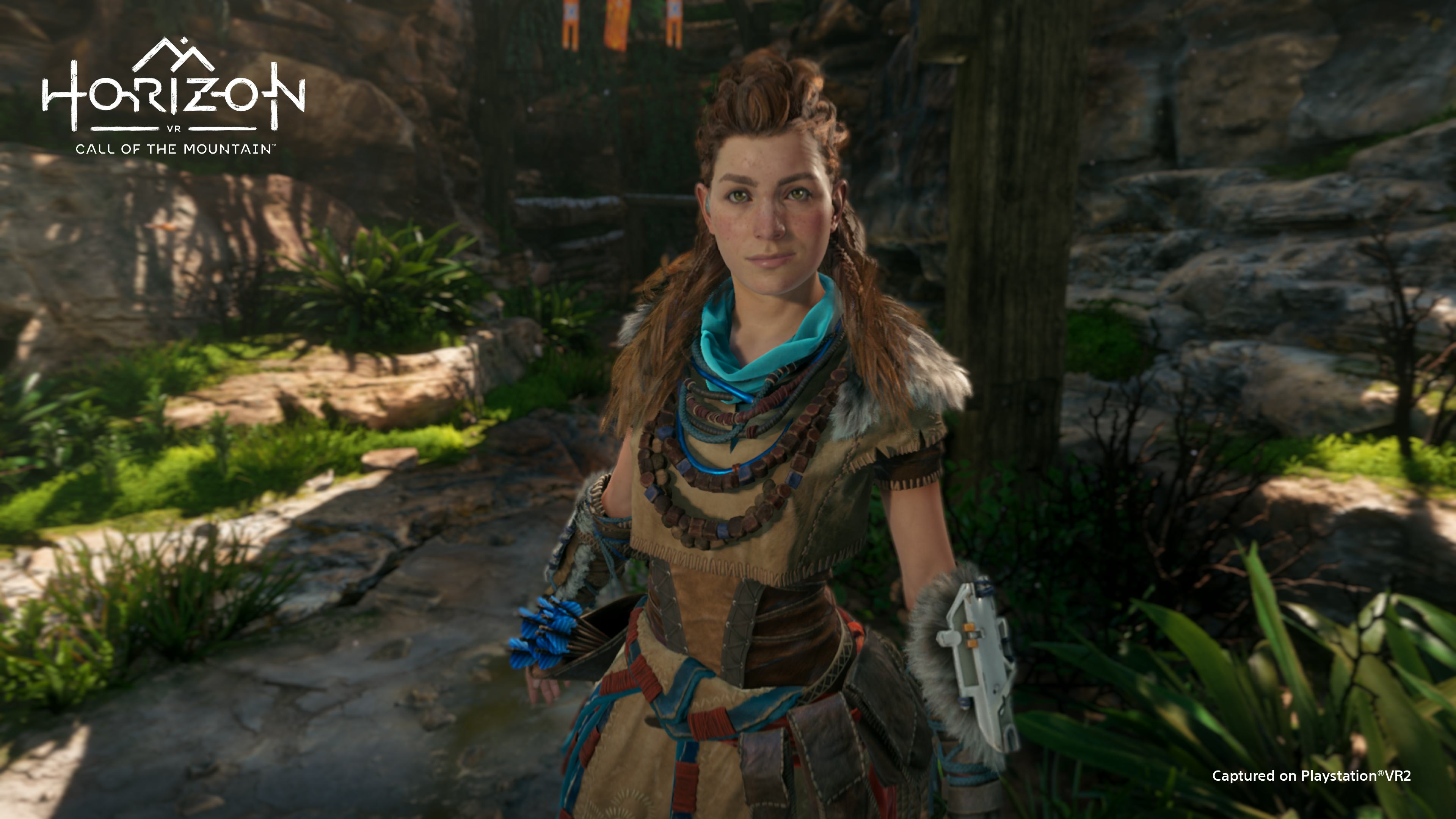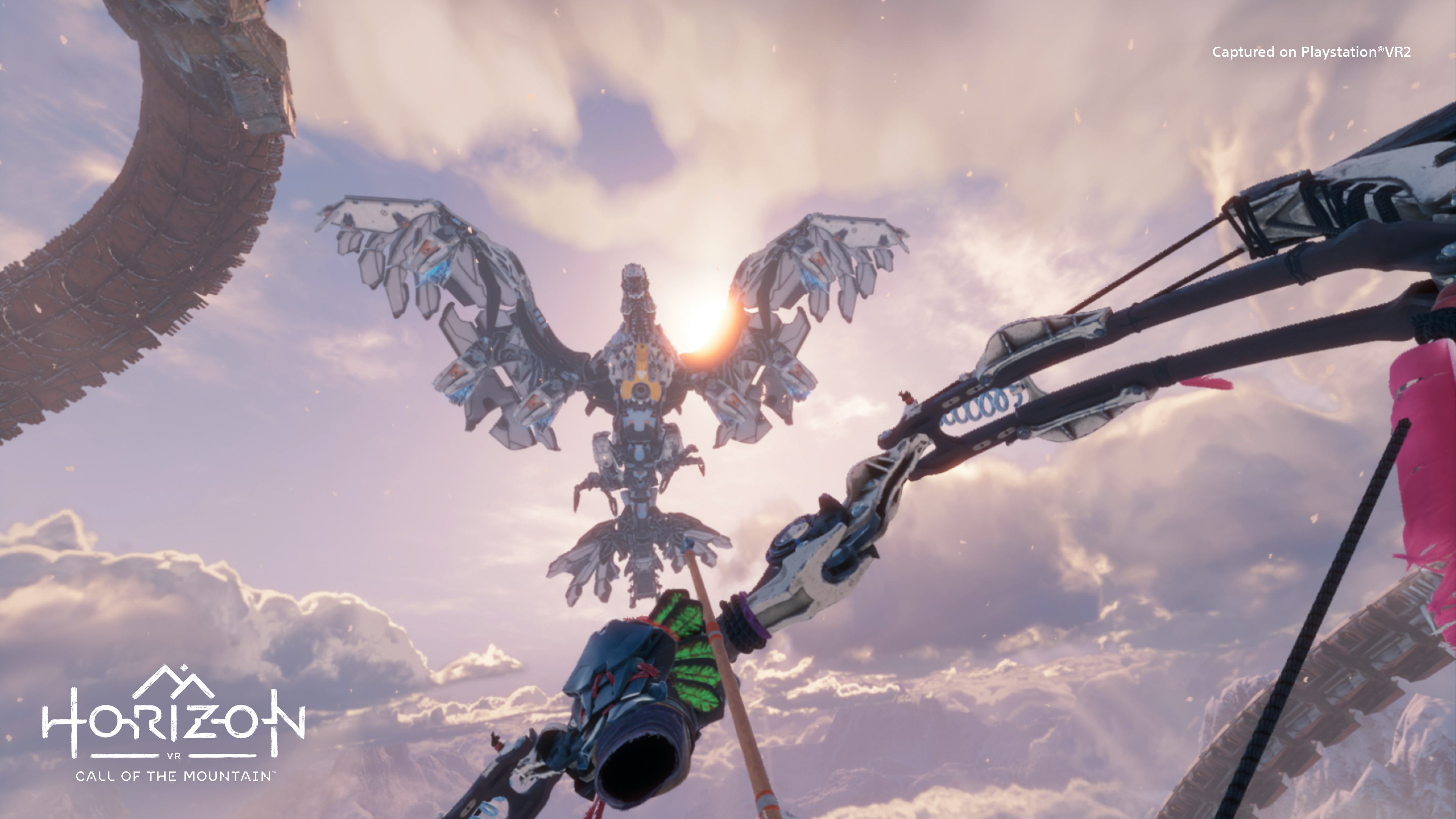
The arrow struck home, smack in the center of the monster’s metallic maw.
I yelped with glee as the beast tumbled to the floor in a shower of sparks. For a brief, shining moment, I actually considered that I might have a natural affinity for archery, a latter-day Robin Hood or Katniss Everdeen.
But after spending a bit more time with Horizon: Call of the Mountain, out February 22 along with Sony’s new virtual reality headset (read our official hardware review here), I realized “innate talents” probably weren’t the source of the magic here. Call of the Mountain succeeds where so many other ambitious VR projects stumble for one reason — it keeps it simple. Core mechanics like traversal and combat have a generous margin of error and can be customized extensively depending on your appetite (or lack thereof) for a challenge. This keeps the focus on immersion and exploration, rather than fiddling with finicky button inputs and timing.
With stunning environments and a gratifying sense of progression, Guerilla and Firesprite have created an astonishing VR game you’ll want to spend hours with. It’s like having a theme-park experience in your very own home.
A Stunning Spectacle

Horizon: Call of the Mountain is a visual marvel from its opening moments. It’s a good thing you start off seated and bound in a canoe because all you’ll want to do for the first several minutes is look around — at the crystal-clear water, the textures of the colorful fabrics your captors wear, the intricate architecture of the ruins crumbling around you, and lumbering mechanical beasts in the distance. There are no black bars, no illusion-shattering sense of looking at a screen.
You play as Ryas, a master climber and disgraced soldier who’s in search of his missing brother, Urid. His quest to find his lost sibling and redeem his past misdeeds will take him to the highest peaks of the Carja Sundom. It’s not the world’s most intricate story, and it really doesn’t need to be. The plot drives you forward without getting in the way of your enjoyment of Call of the Mountain’s incredible world. Even if you’re not well-versed with the Horizon series, like me, you’ll be able to find your footing just fine.

Ryas talks like a combination of Nick Offerman and Arthur Morgan from Red Dead Redemption 2 — oozing tough-guy energy at every moment. At times, it’s a bit much. But I soon found myself relying on these ultra-gruff line reads to keep me paying attention during story scenes, because I spent most of these moments with my head on a swivel, gawking at everything around me like a tourist in Times Square.
As you explore, you’ll stumble across a variety of fun little things to interact with. You can paint on walls, construct stone cairns, and hone your bow skills with some target practice on faraway smoke signals. When you find encampments, you’ll find bowls and urns to appreciatively turn over in your hands, then chuck off the side of a cliff. Instinctively, when I happened upon a cache of green apples, I moved my hand toward my face, lightly whacking my headset with the controller. A bite-shaped morsel disappeared, to my delight. Then another.
I put the virtual apple in my face and I ate it. And it was magical.
Rise and Climb

Call of the Mountain’s gameplay consists of two core components. Traversal is the bulk of the experience and largely consists of scaling ladders, ropes, and mountains. As you progress, you’ll add pickaxes for scrambling up sheer rock faces, and a grappling hook to swing across gaps. These more complex mechanics are introduced gradually, enhancing the experience of scaling ever-taller peaks rather than adding unnecessary complications.
But getting around the Sundom as Ryas doesn’t always work perfectly. Sometimes you’ll be so close to a wall or cliff face that it’s tough to see where to go next. If you’re playing seated, some of the longer grabs you’ll need to pull off while climbing will trigger the PSVR 2 headset’s “out of bounds” warning grid, momentarily breaking the immersion. Sometimes, after particularly lengthy climbing sequences, I struggled to get Ryas to detach from the wall to begin the next sequence, requiring a checkpoint reset to continue the game. (I didn’t lose progress, thanks to frequent autosaves. The team already plans to address the detaching issue with a day one patch.)
Still, these opportunities to remove the headset to regroup are oddly welcome, as Call of the Mountain is perhaps the only VR game I’ve wanted to play for hours on end. When I first set up my PSVR 2, the headset gave me a distinct case of Klingon Brow after about 30 minutes or so. I thought I was a genius for adding a beanie to make the arrangement far comfier — until I took a break after a 90-minute marathon sesh and noticed a deep, cable-knit pattern lacing my forehead. It took several hours — and a night’s sleep! — for the indentations to go away. I still eagerly went back for more, but know that your cranial mileage may vary for this six- to seven-hour experience.

True to the previous installments of the series, Horizon Zero Dawn and Horizon Forbidden West, you’ll need to bust out your bow and arrow to take down the mechanical dinosaurs prowling these verdant lands. This element of the game was perhaps my biggest concern coming in, and the area where the wheels could most easily fall off the wagon. Thankfully, Call of the Mountain’s weaponry benefits from intuitive and simple controls that let you quickly swap your hands or ammo types. It also helps that the baddies are a little bit slower and a little bit dumber than your typical console enemies, keeping the focus squarely on immersion rather than a skill barrier.
We’re still in the fairly early days of VR, and it’s hard to know how well Call of the Mountain is going to age as the technology continues to mature. Will it go down in history as a Mario 64, a Night Trap, or somewhere in between? In any case, at this moment, it’s nothing short of remarkable and will make a believer out of even the most stubborn skeptics. It’s a spectacular achievement that must be experienced to be appreciated.
9/10
Horizon: Call of the Mountain launches on February 22 for PSVR 2.
INVERSE VIDEO GAME REVIEW ETHOS: Every Inverse video game review answers two questions: Is this game worth your time? Are you getting what you pay for? We have no tolerance for endless fetch quests, clunky mechanics, or bugs that dilute the experience. We care deeply about a game’s design, world-building, character arcs, and storytelling. Inverse will never punch down, but we aren’t afraid to punch up. We love magic and science-fiction in equal measure, and as much as we love experiencing rich stories and worlds through games, we won’t ignore the real-world context in which those games are made.







